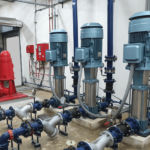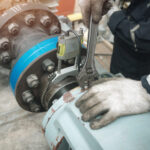
How Does a Centrifugal Pump Work?
When there is a requirement that you need to move fluids from one place to another, the mechanical device that you use is a centrifugal pump. It works quite differently from a regular pump. This centrifugal process pump converts rotational energy into the fluid’s kinetic energy, and then into pressure energy. In industries like water supply plants, wastewater treatment plants, chemical processing industries, heating, ventilation and air-conditioning industries you can see these types of pumps.
What Are the Basic Components of a Centrifugal Process Pump?
Like any other machine, a centrifugal process pump also consists of various components, including the following.
i) Impeller
This is the nucleus or the main component of a centrifugal pump which rotates while the pump is on and produces kinetic energy to the fluid. The impeller has several blades which force the fluid to move outward from the centre of the pump.
ii) Casing
This metallic case covers the impeller and controls the flow of the fluid. It contains inlet (through which the fluid comes in) and outlet (through which the fluid goes out) ports.
iii) Shaft
This is the component that connects the impeller to the motor or other driving mechanism.
iv) Bearing
The bearings fix the shaft through support which helps reduce the friction.
v) Seal
To prevent any kind of fluid leakage around the shaft, you need a seal.
vi) Fan
A fan is fixed in the pump’s body to keep the motor cool or to maintain the heat of the pump. If there was no fan, then the pump could catch fire due to huge energy transfers.
How Does a Centrifugal Pump Work? All Steps Explained
Step 1: The Entry of the Fluid
This is the first step where the fluid enters the pump through the suction piping system and the inlet port. Then it flows towards the impeller.
Step 2: The Generation of the Centrifugal Force
In the next step, the fluid comes to the impeller. The blades of the rotating impeller are carved in such a way, that it produces a centrifugal force that moves the fluid outward towards the casing.
Step 3: The Increment of Velocity and Pressure
This is the step due to which the whole system functions. In this process, as the fluid moves outward, its velocity increases. Also, the pressure of the fluid increases due to the reduction in the cross-sectional area of the casing.
Step 4: Discharge
Next, the fluid goes out from the centrifugal process pump to the outlet piping system. From there, it gets directed to wherever it is supposed to go.
| Requirements to Operate a Centrifugal Process Pump | |
|---|---|
| 1. Power Source | Mainly Electricity. But mechanical drives such as diesel engines or steam turbines are used too. |
| 2. Fluid Supply | Any fluid source to pump in the fluid. For example, a reservoir, tank or pipe |
| 3. Suction Piping | A piping system which can bring the fluid into the pump. |
| 4. Discharge Piping | Another piping system that can carry away the fluid from the pump. |
| 5. Valves | You need valves to control the movement of the inward and outgoing fluid. |
| 6. Priming | Pumps that are located above the fluid level. In this process, first, you need to fill the pump and suction piping with fluid before switching on the pump. |
| 7. Lubrication | You need to lubricate the bearings and seals of the pump from time to time to avoid friction and wear. |
| 8. Support Structure | Vibration and misalignment are the two things that can disbalance the pump while in working condition. So, you need to mount the pump with concrete and provide stable support. |
| 9. Controls | To monitor and control the operations, you need a motor starter, pressure switches and flow meters. |
| 10. Maintenance | Regular maintenance through thorough inspection is needed for the pump’s performance and longevity. |
Different Types of Centrifugal Pumps
Depending upon their mechanism and uses, there are several types of centrifugal pumps with unique characteristics. Check out the following for the same.
-
Single-Stage Pumps
These pumps have a single impeller. They are suitable for low to moderate-head applications. For example, these pumps are used in
i) Wastewater treatment (to pump wastewater from sewage treatment plants)
ii) HVAC Systems (used in heating, ventilation and air-conditioning) -
Multi-Stage Pumps
These pumps have multiple impellers which are arranged in a series connection. This type of model helps to handle higher-pressure situations. Multi stage pump is often used in power station applications. For example, they are used in
i) Firefighting (to extinguish fire)
ii) Power Plants (Used as boiler feedwater pumps to pump feedwater into a steam boiler)
iii) Irrigation (to pump water for the irrigation process) -
Vertical Pumps
The impeller is mounted vertically in this type of pump. This type of mechanism is suitable for deep wells or reservoirs. We are the best vertical centrifugal pump manufacturer.
-
Horizontal Pumps
For these types of pumps, the impeller is mounted horizontally. They are versatile and easier to install.
Buy the Best Quality Centrifugal Chemical Pump Today
When buying a pump from a leading centrifugal chemical pump manufacturer, make sure that you discuss the technicalities with them. Look for all-purpose heavy-duty centrifugal pumps at reasonable rates. Apart from manufacturing and selling pumps, they should also take care of regular maintenance because only professionals can deal with the issues (if there are any) and can guide you best. Talk to an experienced engineer today, let them know your requirements and clear your doubts related to the operation mechanism, maintenance, rates, and more.




